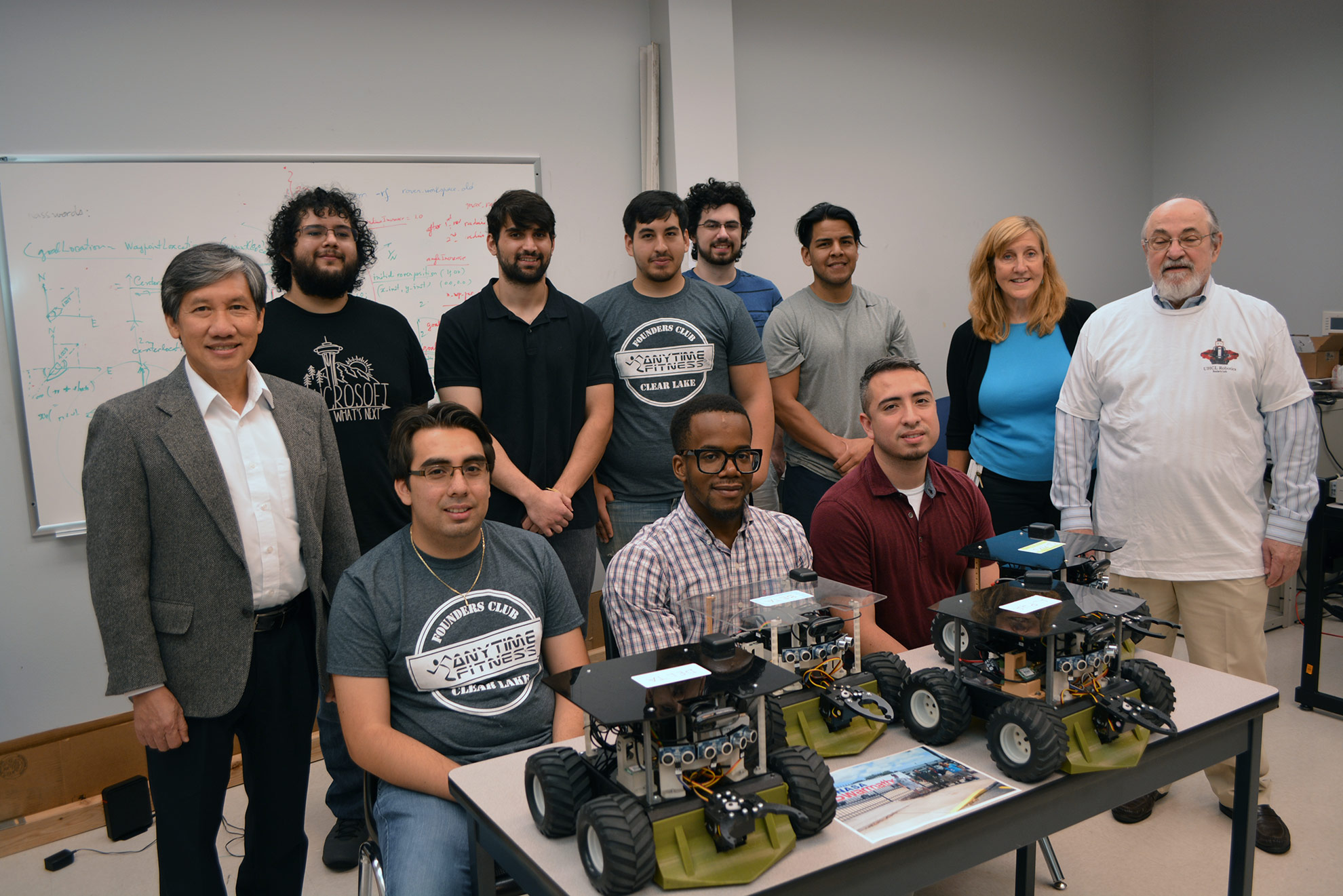- Future Students
- How to Apply
- Visit UHCL
- Admitted Students
- Tuition, Costs and Aid
- Degrees and Programs
- Contact Admissions
- Current Students
- Class Schedule
- Academic Calendar
- Advising
- Events
- Library
- Academic Resources and Support
- Student Services and Resources
- Alumni
- Lifetime Membership
- Alumni Events
- Update Your information
- Awards and Recognitions
- Give to UHCL
UHCL Swarmathon team pushing robotics to new frontiers
June 9, 2017 | Jim Townsend

Neal Stephenson’s 2015 bestselling science-fiction novel “Seveneves” introduces readers
to a mining engineer aboard the International Space Station whose swarms of tiny robots
align themselves into autonomous, cooperative, intelligent collectives for each new
task. The fiction of 2015 is a step closer to a reality in 2017 because of a team
of University of Houston-Clear Lake computer engineering students and their professors
who are in working with NASA and many others to advance the field of “swarm robotics.”
The UHCL team, in partnership with a team of students from San Jacinto College North, recently competed against other minority-serving institutions in NASA’s 2017 Swarmathon, moving up to fourth place from sixth place in 2016 amid tougher competition. NASA’s Minority University Research Program funds the events, which are organized by the University of New Mexico’s Moses Biological Computation Lab and held at Kennedy Space Center in Cape Canaveral, Fla. Last year, 24 minority-serving colleges and universities brought more than 400 students to the competition. This spring, more than 40 institutions participated with more than 600 students.
NASA has been interested in swarm robotics since at least 1997, as cited in UHCL’s scholarly archives. In this technology, robots would behave like colonies of ants or swarms of bees – each individual working autonomously but also cooperatively, responding to changing stimuli by adapting to new purposes. It’s been the staple of sci-fi writers and movies for decades. While the technology has yet to catch up to imagination, in recent years it’s become far more feasible, said UHCL Professor of Computer Engineering Thomas L. Harman who serves as director of the newly formed Center for Robotics Software or CRS.
“It’s coming faster than anyone thought it would,” said Harman. “Transistors took about 20 years to really get integrated into electronics. The Computer Revolution took about 10 years. The robots developing artificial intelligence and human-like capabilities may only take a couple years to become reality. And development activity is accelerating.”
At Swarmathon, teams compete in virtual and physical competitions, writing code to instruct NASA-provided robotic rovers – called “Swarmies” – which autonomously search for cubes and retrieve them to a central location. Physical teams upload their code to the rovers. Virtual teams develop distributed search and communication algorithms for Swarmies running in a simulation. Physical and virtual teams compete for cash prizes of up to $5,000 for those rovers that autonomously seek and collect the most cubes.
“In order to accomplish such a difficult feat, they must focus on specific parts of the problem,” said UHCL Visiting Researcher Carol Fairchild, who is also CRS co-director. “This year the students mastered the challenge of identifying and picking up the cubes through many hours of software modification and testing. We still have the challenge of the robots finding their way back to the center drop-off location. Having the robot know where it is at all times is the biggest challenge of this competition. Communicating to one another the locations of clusters of cubes is the ultimate problem to overcome.”
Fairchild said that one of the big advantages of the competition is the sharing of technical breakthroughs among all the teams. She added that students also heard NASA astronauts and engineers who emphasized that these sorts of technical challenges were part of every engineering process at the space agency.
Fairchild accompanied the 2017 team. Harman attended the 2016 competition. The team’s faculty adviser, Assistant Professor of Computer Engineering Luong Nguyen, attended both events and will also advise the 2018 team.
Nguyen said the 2018 team will face new challenges. The rovers will encounter obstacles, which will require even more complicated programs to enable the rovers to autonomously identify and circumnavigate those obstacles. Several students have already been recruited to the 2018 team, he said. They will spend this summer honing their programming skills and becoming familiar with the Swarmies.
“We have made the Swarmathon competition a qualified senior project for the students of the Senior Project class in the Computer Engineering Department,” Nguyen said. “Our computer engineering students tend to be strong in hardware but not quite as prepared for the software challenge of Swarmathon. So we are starting early in preparation for the 2018 competition.”
Find out more about educational opportunities in computer engineering by visiting www.uhcl.edu/science-engineering/ or calling 281-283-3700.






